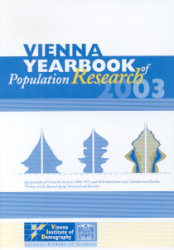Contents:
Reprints
Lutz/Sanderson/Scherbov: The end of world population growth; Lutz/Goujon: The world´s changing human capital stock: multi-state population projections by educational attainment; Lee/Schmidt-Dengler/Felderer/Helmenstein: Austrian demography and housing demand: is there a connection?; Lutz/Scherbov/Prskawetz/Dworak/Feichtinger: Population, natural resources, and food security: Lessons from comparing full and reduced-form models; MacKellar: The predicament of population aging: a review essay; Hoem/Prskawetz/Neyer: Autonomy or conservative adjustment? The effect of public policies and educational attainment on third births in Austria; Engelhardt/Trappe/Dronkers: Differences in family policy and intergenerational transmission of divorce: a comparison between the former East and West Germany; Spielauer/Vencatasawmy: FAMSIM: dynamic microsimulation of life course interactions between education, work, partnership formation and birth in Austria, Belgium, Italy, Spain and Sweden;
New Articles
Buber-Ennser: The influence of the distribution of household and childrearing tasks between men and women on childbearing intentions in Austria; Lutz/Scherbov/Hanika: "Vienna: a city beyond aging" - revisited and revised; Riedel/Hofmarcher: Austrian health expenditures exhibit an age profile |
Vienna Yearbook of Population Research 2003
ISSN 1728-4414
Print Edition
ISSN 1728-5303
Online Edition
ISBN 978-3-7001-3164-9
Print Edition
ISBN 978-3-7001-3212-7
Online Edition

|
Send or fax to your local bookseller or to:
Verlag der Österreichischen Akademie der Wissenschaften
Austrian Academy of Sciences Press
A-1011 Wien, Dr. Ignaz Seipel-Platz 2,
Tel. +43-1-515 81/DW 3420, Fax +43-1-515 81/DW 3400
https://verlag.oeaw.ac.at, e-mail: bestellung.verlag@oeaw.ac.at
UID-Nr.: ATU 16251605, FN 71839x Handelsgericht Wien, DVR: 0096385
Bitte senden Sie mir
Please send me |
|
Exemplar(e) der genannten Publikation
copy(ies) of the publication overleaf |
NAME
|
ADRESSE / ADDRESS
|
ORT / CITY
|
LAND / COUNTRY
ZAHLUNGSMETHODE / METHOD OF PAYMENT
Visa Euro / Master American Express
|
NUMMER
|
Ablaufdatum / Expiry date:
I will send a cheque
Vorausrechnung / Send me a proforma invoice
|
|




